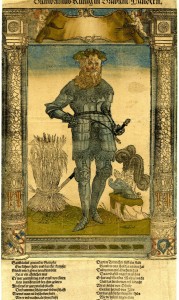Was John of Brabant a beer god? (1)
 You may have noticed him on the European mainland: the legendary beer king Gambrinus. Omnipresent in German pubs, Dutch beer labels, Czech advertising posters, and so on. A jolly bearded guy, crown on his head, beer in his hand. A ‘Santa Claus of beer’ if you like. But where does he come from? Was he once a real person, like duke John I of Brabant, as is often claimed?
You may have noticed him on the European mainland: the legendary beer king Gambrinus. Omnipresent in German pubs, Dutch beer labels, Czech advertising posters, and so on. A jolly bearded guy, crown on his head, beer in his hand. A ‘Santa Claus of beer’ if you like. But where does he come from? Was he once a real person, like duke John I of Brabant, as is often claimed?
Brabant is a region that today is split among the Netherlands and Belgium. And all sorts of stories about this Medieval duke John of Brabant abound. Wasn’t he called ‘Jan Primus’? Didn’t he give his name to the legendary beer king Gambrinus? Didn’t he grant privileges to the brewers of Brabant, didn’t he tell his soldiers to ‘drink like their ancestors’? Beer writers like Michael Jackson and even The Oxford Companion to Beer make such claims, so it must be true, right? Right? But well, unfortunately it’s all a load of bollocks, and I’ll show you why.
First we’ll have a look at Gambrinus. Where does this figure come from? To find the answer we must go back all the way to Roman Antiquity. In about the year 98 AD senator Tacitus wrote a short history of the Germans, a primitive people living north of the Rhine and the Alps. Actually it isn’t such a long work, no more than 15 pages if you print it. On the origin of the Germans, he claims that they worshipped a god called Teuto and his son Mannus as their oldest ancestors. Then, it says:
To Mannus they assign three sons, from whose names, they say, the coast tribes are called Ingaevones; those of the interior, Herminones; all the rest, Istaevones. Some […] assert that the god had several descendants, and the nation several appellations, as Marsi, Gambrivii, Suevi, Vandilii, and that these are genuine old names.[1]
To today’s historians, the names the Romans used for the various German tribes form a big jigsaw puzzle. After all, the Germans didn’t write down anything about their existence themselves, and the Romans frequently got things wrong. The Gambrivians (‘Gambrivios’), of which Tacitus says they didn’t exist, are elsewhere only mentioned in passing by Greek scientist Strabo in his encyclopaedic work Geographia from the early first century, and that’s about it.[2]
After that, nothing much happens, at least as far as concerned the Gambrivians, who may have or have not existed. But the Germans advance. The Romans adopt Christianity. The Western Empire falls. Great migrations. Charlemagne. Cathedral builders. The Middle Ages. The Black Death. More than a thousand years pass and Tacitus’ work is forgotten. However, in the year 1425 a copy was discovered at Hersfeld Abbey in Germany. It was taken to Italy and spread further. It was from this moment on that the word ‘Germans’ was used again – it had fallen into disuse after the Roman period. (In English, Germans were called ‘Almain’ or ‘Dutch’ until then.) These were the times of Renaissance and Humanism: scientists started to examine the old Roman and Greek texts again, put Antiquity on a pedestal and condescendingly spoke of the period that came after as the ‘Middle Ages’.
But ehm, what does all of this have to do with beer? So far, nothing. But the publication of Tacitus’ work will provoke a chain reaction that will eventually give us the mythical beer king Gambrinus. It all started with the Italian monk Annius of Viterbo, who published his book Antiquitatum Variarum in 1498. In it, he quoted various classical texts, to that date unknown, that among other things shed a light on the origin of the Germans. Annius claimed there were ten legendary kings: Teutus, Mannus, Marsus, Gambrivius, Suevus, Vandalus… It gained him instant popularity, especially in Germany, where people were overjoyed to find that their history went back much further than they had thought.[3]
 But perhaps you saw it coming: Annius of Viterbo’s writings were just a big hoax. He had largely invented the quotes by classical historians, just like he had invented the long list of Germanic kings. But he had done his homework: one of the sources for his fabrications was Tacitus. In the names of the legendary kings, we can recognise a few of the tribes Tacitus mentioned. And hadn’t Tacitus himself claimed that the tribes’ names were derived from ‘sons of the gods’? The Germans rubbed their hands with glee: we told you so, Tacitus was right and brother Annius proved it.
But perhaps you saw it coming: Annius of Viterbo’s writings were just a big hoax. He had largely invented the quotes by classical historians, just like he had invented the long list of Germanic kings. But he had done his homework: one of the sources for his fabrications was Tacitus. In the names of the legendary kings, we can recognise a few of the tribes Tacitus mentioned. And hadn’t Tacitus himself claimed that the tribes’ names were derived from ‘sons of the gods’? The Germans rubbed their hands with glee: we told you so, Tacitus was right and brother Annius proved it.
From a people (Gambrivios) we are now suddenly talking about a king (Gambrivius). And from there, things go quickly, also because of the printing press, which enabled rapid distribution of books. Annius claimed Gambrivius was a contemporary of the Syrian king Belochus, which placed him in the 18th century BC. German historian Johannes Aventinus, writing his Annales Bojorum (History of Bavaria) in the sixteenth century, then made up that Germany owed the knowledge of brewing beer to Gambrivius’ son, Suevus. Allegedly, he would have taken the Egyptian goddess Isis to Germany where she showed him the ropes.[4]
To us, stories like these sound like easily detectable bollocks, but in the 1500s humanists still had to invent history as a science. Based on the few texts they had from Antiquity, some of them forgeries, they had to make the most of it. The next person to add something to the story was German scholar Andreas Althamer, who wondered: this legendary king Gambrivius, where exactly was his kingdom? Althamer based himself on the scant available data mentioned above, and equated the tribe of the Gambrivii to that of the Sicambri, of which much more was known. And didn’t these Sicambri, after a few wanderings, live South of the Rhine? Like in the land of Mons and Guelders? And wasn’t the city of Cambrai (now Northern France) named after them?[5]
It was pure guesswork, as we can now safely say. But we’re getting closer to the Duchy of Brabant. Now poets and other creatives took over. For a start there was the Hainaut poet Jean Lemaire de Belges, who claimed that not Isis, but Osiris had brought the art of brewing to Germany (which didn’t come completely out of thin air, as classical author Siculus had mentioned Osiris as the one who had introduced ‘a beverage made from barley’ in places were vines wouldn’t grow).[6] More important however was that Lemaire changed the v of Gambrivius into an n. It probably was a typo, but one that would live on for a long time.[7]
The legend would get its definitive form through German poet Burkard Waldis, when he compiled his Origin and provenance of the first twelve old kings and monarchs of the German nation in 1543. Twelve poems about twelve mythical German kings. The so far quite inconsistent story of the origin of German brewing featuring Isis and Osiris, was now concentrated on Gambrivius, who was also designated ‘King in Brabant/Flanders’ for the first time. A king who learnt brewing beer from the two deities. On him, we read:
He made malt from barley
And came up with beer brewing first
As he learnt such from Osiris
And from Isis.
 The illustration, printed by Hans Guldenmundt, shows a fully harnessed king with hops on his head, a helmet in his hand and a bundle of barley behind him.[8] It’s almost beer king Gambrinus as we know him, only the crown and the jug of beer are still missing. And of course the corruption from the v into an n in his name still had to be adopted generally. However, by 1568 rhetoric Marcus van Vaernewijck from Gent was using exactly that spelling.[9]
The illustration, printed by Hans Guldenmundt, shows a fully harnessed king with hops on his head, a helmet in his hand and a bundle of barley behind him.[8] It’s almost beer king Gambrinus as we know him, only the crown and the jug of beer are still missing. And of course the corruption from the v into an n in his name still had to be adopted generally. However, by 1568 rhetoric Marcus van Vaernewijck from Gent was using exactly that spelling.[9]
Still, what is the connection between Gambrivius/Gambrinus and that Duke John of Brabant? How did a king made up by humanists become a staple decoration of countless pubs and breweries? We’ll have a look at that in the next article.[10]
[1] Alfred John Church and William Jackson Brodribb (translation), The Origin and Situation of the Germans, 1876.
[2] Strabo, Geographia, Book VII chapter 1.
[3] Ronald Donenfeld, Aureus Libellus. Tactus’ Germania en het Duitse humanisme 1457-1544, Utrecht 1997, p 38-40.
[4] Werner Waterschoot), De ‘Poeticsche werken’ van Jan van der Noot, Gent 1975, p. 90.
[5] Andreas Althamer, Germaniae veteris et novae descriptio accuratissima, Frankfurt 1617, p. 96-97. Reissue of the work from 1536.
[6] Diodorus Siculus, Bibliotheca Historica, Book I.
[7] Waterschoot, ‘Poeticsche werken’, p. 90.
[8] ‘Gambrivius, Künig in Brabant/ Flandern’, print issued by Hans Guldenmundt, designed by Peter Flötner and Nikolaus Stör, published in Nuremberg, 1543. Collection British Museum, London, inv. no. E.8.284.
[9] Waterschoot, ‘Poeticsche werken’, p. 90.
[10] This article was based on an earlier version in Dutch, http://verlorenbieren.nl/was-hertog-jan-een-biergod/.






Leave a Reply